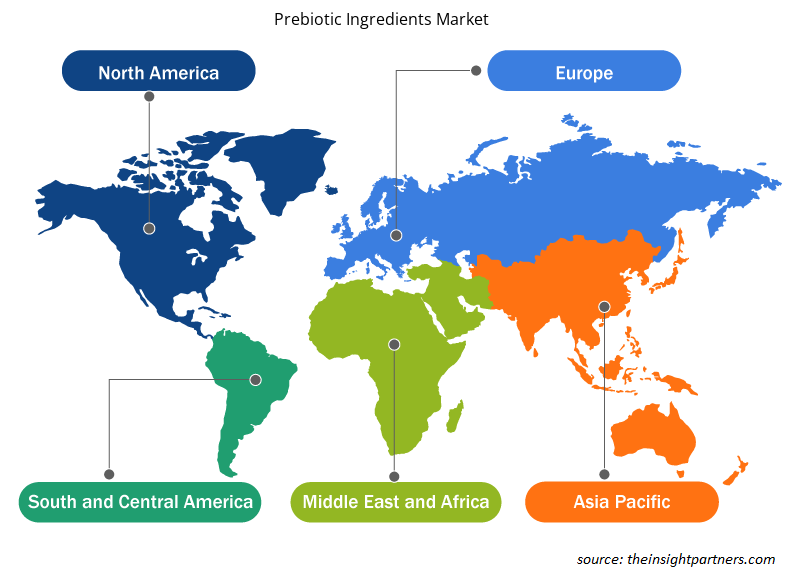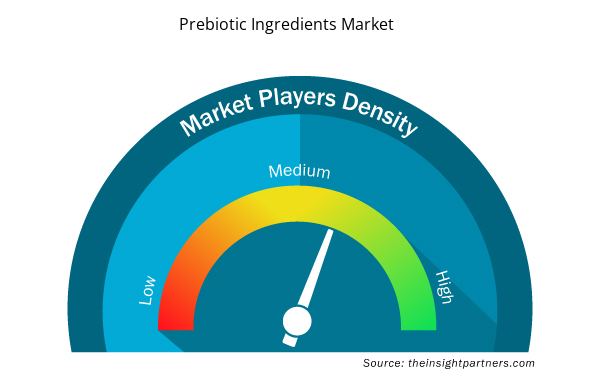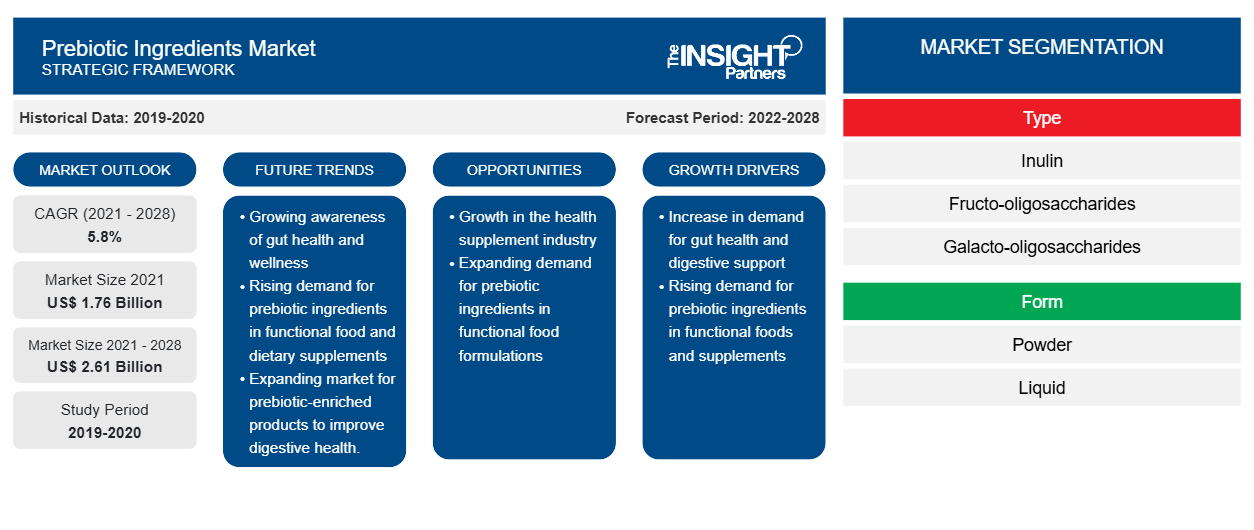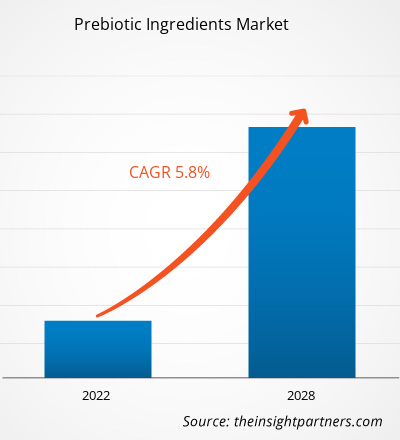[Rapport de recherche] Le marché des ingrédients prébiotiques devrait passer de 1 758,40 millions USD en 2021 à 2 607,72 millions USD en 2028 ; il devrait croître à un TCAC de 5,8 % de 2022 à 2028.
Les prébiotiques sont des composés présents dans les aliments qui induisent la croissance ou l'activité de micro-organismes bénéfiques tels que les bactéries et les champignons. La fermentation est le principal mécanisme d'action par lequel les bactéries bénéfiques utilisent les prébiotiques dans le côlon. Les prébiotiques jouent un rôle important dans les soins de santé préventifs, car la popularité croissante des compléments nutraceutiques riches en fibres parmi les amateurs de sport et les athlètes pour renforcer leur endurance et leur résistance augmente encore la demande d'ingrédients prébiotiques. Ainsi, la sensibilisation croissante aux soins de santé préventifs stimule la croissance du marché des ingrédients prébiotiques.
L'Asie-Pacifique détenait la plus grande part de marché des ingrédients prébiotiques en 2021, tandis que d'autres régions en développement, telles que le Moyen-Orient et l'Afrique, devraient connaître une croissance significative au cours de la période de prévision. La croissance du marché est attribuée à l'augmentation des troubles de la santé intestinale et immunitaire associés à l'augmentation des maladies digestives. Les pays asiatiques ont tendance à adopter des aliments et des boissons sains et nutritifs pour améliorer la santé intestinale. Par conséquent, la tendance à adopter des aliments sains stimule la croissance du marché des ingrédients prébiotiques.
Personnalisez ce rapport en fonction de vos besoins
Vous bénéficierez d'une personnalisation gratuite de n'importe quel rapport, y compris de certaines parties de ce rapport, d'une analyse au niveau des pays, d'un pack de données Excel, ainsi que de superbes offres et réductions pour les start-ups et les universités.
- Obtenez les principales tendances clés du marché de ce rapport.Cet échantillon GRATUIT comprendra une analyse de données, allant des tendances du marché aux estimations et prévisions.
Impact de la pandémie de COVID-19 sur le marché des ingrédients prébiotiques
La pandémie de COVID-19 a posé des défis sans précédent à de nombreux secteurs au début de l’année 2020. Les confinements, les restrictions aux frontières, les interdictions de voyager, l’arrêt de la fabrication et d’autres mesures de sécurité mises en place par les gouvernements conformément aux directives de l’OMS et des ministères nationaux de la santé ont entravé les opérations de fabrication. Cependant, l’épidémie de COVID-19 a eu un impact positif sur le marché, car les consommateurs recherchaient de plus en plus des alternatives naturelles et plus sûres pour rester en bonne santé et renforcer leur système immunitaire. La demande de compléments alimentaires a augmenté de façon spectaculaire au cours des premiers mois de la pandémie de COVID-19. De plus, comme les gens sont restés chez eux en raison des mandats gouvernementaux, ils se sont concentrés sur leur santé et leur forme physique, ce qui a stimulé la demande de prébiotiques pendant la pandémie de COVID-19.
Informations sur le marché
Demande croissante d'ingrédients prébiotiques dans le secteur de l'alimentation et des boissons
La popularité des prébiotiques augmente dans l'industrie alimentaire et des boissons en raison de leur application dans les barres nutritionnelles, les produits laitiers, les boissons diététiques, les compléments minéraux, les céréales pour petit-déjeuner, les produits de boulangerie, les confiseries, les aliments verts et les préparations pour nourrissons. En novembre 2018, la société Kellogg a lancé une nouvelle céréale, sous la marque HI! Happy Inside, comprenant des prébiotiques et des probiotiques, dans le cadre de sa gamme de produits digestifs stimulant l'intestin. De plus, l'inuline est largement utilisée dans la transformation des aliments car elle constitue un substitut sain et efficace aux graisses et au sucre. Les principaux pays producteurs de lait tels que les États-Unis, l'Inde et la Chine utilisent des prébiotiques pour donner la texture souhaitée aux produits finis et fabriquer des produits laitiers sans sucre. De plus, les préparations pour nourrissons ou les aliments pour bébés contiennent divers ingrédients prébiotiques, notamment des galacto-oligosaccharides, des fructo-oligosaccharides et du polydextrose. Ce sont les facteurs qui stimulent la croissance du marché des ingrédients prébiotiques.
Informations basées sur les types
En fonction du type, le marché des ingrédients prébiotiques est segmenté en inuline, fructo-oligosaccharides (FOS), galacto-oligosaccharides (GOS), mannan-oligosaccharides (MOS) et autres. Le segment de l'inuline devrait enregistrer la plus grande part au cours de la période de prévision. Les fabricants l'utilisent dans les aliments et boissons transformés, les compléments alimentaires et les aliments pour animaux pour remplacer le sucre, les graisses et la farine. Aux États-Unis, en 2018, la Food and Drug Administration a approuvé l'inuline comme ingrédient de fibres alimentaires pour améliorer la valeur nutritionnelle des produits alimentaires manufacturés. De plus, la demande croissante de produits naturels augmente la demande d'inuline prébiotique dans le monde entier. La croissance du segment de l'inuline est tirée par l'augmentation des applications dans diverses industries, alimentant la croissance du marché des ingrédients prébiotiques.
Informations basées sur les formulaires
En fonction de la forme, le marché des ingrédients prébiotiques est segmenté en poudre et en liquide. Le segment de la poudre devrait enregistrer un TCAC plus élevé sur le marché au cours de la période de prévision. La forme en poudre a facilité la distribution et l'utilisation de la consommation de prébiotiques. L'avantage de l'utilisation de poudre prébiotique pour la production animale a gagné en popularité car les prébiotiques en poudre sont accessibles à la consommation à n'importe quel stade de la vie du bétail. De plus, la productivité croissante des viandes, des œufs et du lait augmente la demande de prébiotiques en poudre.
Informations basées sur les applications
En fonction de l'application, le marché des ingrédients prébiotiques est segmenté en aliments et boissons fonctionnels, compléments alimentaires, aliments pour animaux et autres. Le segment des compléments alimentaires devrait enregistrer le TCAC le plus élevé du marché au cours de la période de prévision. La demande croissante de médicaments préventifs, le nombre croissant de troubles digestifs chez les personnes âgées et l'absence d'une alimentation équilibrée sont susceptibles d'accroître la demande de produits dans l'industrie des compléments alimentaires. Les consommateurs préfèrent de plus en plus les compléments alimentaires à base de prébiotiques en raison de l'adoption croissante de régimes alimentaires malsains.
Les principaux acteurs opérant sur le marché des ingrédients prébiotiques sont BENEO GmbH ; COSUCRA ; DuPont Nutrition & Biosciences ; Clasado Ltd. ; Nexira ; Ingredion Incorporated ; SOLACTIS ; Cargill, Incorporated. ; Sensus ; et Roquette Frères. Ces acteurs sont engagés dans le développement de produits à risques réduits pour la santé afin de répondre aux nouvelles tendances de consommation et de respecter les cadres réglementaires. Ils sont impliqués dans des fusions et acquisitions, des expansions d'entreprises et des partenariats pour accroître leur part de marché.
Aperçu régional du marché des ingrédients prébiotiques
Les tendances régionales et les facteurs influençant le marché des ingrédients prébiotiques tout au long de la période de prévision ont été expliqués en détail par les analystes d’Insight Partners. Cette section traite également des segments et de la géographie du marché des ingrédients prébiotiques en Amérique du Nord, en Europe, en Asie-Pacifique, au Moyen-Orient et en Afrique, ainsi qu’en Amérique du Sud et en Amérique centrale.

- Obtenez les données régionales spécifiques au marché des ingrédients prébiotiques
Portée du rapport sur le marché des ingrédients prébiotiques
| Attribut de rapport | Détails |
|---|---|
| Taille du marché en 2021 | 1,76 milliard de dollars américains |
| Taille du marché d'ici 2028 | 2,61 milliards de dollars américains |
| Taux de croissance annuel moyen mondial (2021-2028) | 5,8% |
| Données historiques | 2019-2020 |
| Période de prévision | 2022-2028 |
| Segments couverts | Par type
|
| Régions et pays couverts | Amérique du Nord
|
| Leaders du marché et profils d'entreprises clés |
|
Densité des acteurs du marché des ingrédients prébiotiques : comprendre son impact sur la dynamique commerciale
Le marché des ingrédients prébiotiques connaît une croissance rapide, tirée par la demande croissante des utilisateurs finaux en raison de facteurs tels que l'évolution des préférences des consommateurs, les avancées technologiques et une plus grande sensibilisation aux avantages du produit. À mesure que la demande augmente, les entreprises élargissent leurs offres, innovent pour répondre aux besoins des consommateurs et capitalisent sur les tendances émergentes, ce qui alimente davantage la croissance du marché.
La densité des acteurs du marché fait référence à la répartition des entreprises ou des sociétés opérant sur un marché ou un secteur particulier. Elle indique le nombre de concurrents (acteurs du marché) présents sur un marché donné par rapport à sa taille ou à sa valeur marchande totale.
Les principales entreprises opérant sur le marché des ingrédients prébiotiques sont :
- Beneo GmbH
- COSUCRA
- DuPont
- Classement Limité
- Nexira
Avis de non-responsabilité : les sociétés répertoriées ci-dessus ne sont pas classées dans un ordre particulier.

- Obtenez un aperçu des principaux acteurs du marché des ingrédients prébiotiques
Rapports en vedette
- Tendances industrielles progressistes sur le marché des ingrédients prébiotiques pour aider les acteurs à développer des stratégies efficaces à long terme
- Stratégies de croissance des entreprises adoptées pour assurer la croissance sur les marchés développés et en développement
- Analyse quantitative du marché des ingrédients prébiotiques de 2022 à 2028
- Estimation de la demande mondiale en probiotiques
- Analyse des cinq forces de Porter pour illustrer l'efficacité des acheteurs et des fournisseurs opérant dans l'industrie
- Développements récents pour comprendre le scénario concurrentiel du marché
- Tendances et perspectives du marché et facteurs régissant la croissance du marché des ingrédients prébiotiques
- Aide à la prise de décision en mettant en évidence les stratégies de marché qui sous-tendent l'intérêt commercial, conduisant à la croissance du marché
- Taille du marché des ingrédients prébiotiques à différents niveaux
- Aperçu détaillé et segmentation du marché et de la dynamique de l'industrie des probiotiques
- Ampleur de la croissance dans diverses régions présentant des opportunités de croissance prometteuses
- Analyse historique (2 ans), année de base, prévision (7 ans) avec TCAC
- Analyse PEST et SWO
- Taille du marché Valeur / Volume - Mondial, Régional, Pays
- Industrie et paysage concurrentiel
- Ensemble de données Excel



Report Coverage
Revenue forecast, Company Analysis, Industry landscape, Growth factors, and Trends

Segment Covered
This text is related
to segments covered.

Regional Scope
North America, Europe, Asia Pacific, Middle East & Africa, South & Central America

Country Scope
This text is related
to country scope.
Questions fréquemment posées
Increasing consumers’ focus on preventive health driving global prebiotic Ingredient’s market. Over the past few years, the awareness regarding health and nutrition has increased significantly. Because of hectic work schedules and extended working hours, people pay less attention to their daily diet, health, and fitness. Ignorance about proper diet may lead to various health issues such as obesity, diabetes, and digestive problems. This drives people’s focus toward preventive health and dietary supplements that offer health benefits without harmful effects. Prebiotics-infused supplements are known for their ability to nourish human gut flora and significantly boost their metabolic activity, hence improving digestion, nutrition absorption, and immune systems while inhibiting harmful microbe growth. Mannan-oligosaccharides (MOS) are a special prebiotic ingredient that interferes with the binding and colony formation of pathogens. Thus, it acts as a blocking agent in the intestinal area. Moreover, prebiotic supplements may offer health benefits, such as decreasing anxiety and alleviating irritable bowel syndrome (IBS) symptoms. A healthy digestive system has been linked to mental health and immune response improvements. These factors are significantly boosting the demand for such ingredients among consumers, eventually boosting the growth of the prebiotic ingredients market.
Based on the application, functional food & beverages segment is projected to grow at the fastest CAGR over the forecast period. The growing popularity of functional food & beverages driving the prebiotic ingredients market. The increasing demand for functional food is due to increased health issues among the population. This is due to the increasing consumption of functional foods to maintain & promote the gut health. Hence the rising diseases & health issues further projected the rise in demand for functional foods during the forecast period.
Further, the fortified foods are gaining popularity across the globe owing to the increased awareness of benefits among the population. Fortified foods usually produced with adding nutrients in it. Hence, the adding of essential nutrients tends to prevent the chronic diseases such as diabetes, heart diseases, and cancer. Hence, the consumption of fortified food is increasing worldwide, and further fueling the prebiotic ingredients market.
Asia Pacific accounted for the largest share of the global prebiotic Ingredients market. Asia Pacific prebiotic ingredients market is segmented into China, India, Australia, Japan, South Korea, and the Rest of Asia Pacific. The market growth is attributed to increasing gut health and immune health disorders coupled with growing digestive diseases. The Asian countries are inclining toward adopting healthy and nutritious food items and beverages to improve gut health. Hence, inclination towards adopting healthy food is driving the growth of the prebiotic ingredients market. Further, the growing awareness about the health benefits of prebiotics in animal health are creating substantial demand for prebiotic-based feeds such as lactulose, mannan-oligosaccharide (MOS), inulin, soy fructo-oligosaccharide (FOS) and galacto-oligosaccharide (GOS). As livestock and farm animals contribute significantly to the food supply chain, the demand for prebiotic-rich animal feeds is expected to grow during the forecast period.
The major players operating in the global prebiotic Ingredients market are Beneo GmbH; COSUCRA; DuPont; Clasado Limited; Nexira; Ingredion; Solactis; Cargill, Incorporated; Sensus; Roquette Freres.
Rising demand for prebiotics in animal feed anticipate lucrative opportunities for the prebiotic ingredients market. Animal feed with prebiotics as an additive has been shown to increase the yield. Mannan-oligosaccharides are used in poultry feed as an alternative to antibiotics. Rising cases of digestive disorders in livestock, such as enteric infections and acidosis, further agitate the industry landscape. The numerous advantages of prebiotics on animal health, such as triggered animal growth rate, and milk and egg yield, are anticipated to drive the demand for prebiotics in animal feed.
Based on type, inulin segment has largest revenue share. Inulin is a starchy prebiotic fiber found in various fruits, vegetables, and herbs, including wheat, onions, bananas, chicory, artichokes, and asparagus. Insulins are a group of naturally occurring polysaccharides, a heterogeneous collection of fructose polymers whose flavor ranges from bland to subtly sweet. Manufacturers use it in processed food and beverages, dietary supplements, and animal feed to replace sugar, fat, and flour. In the US in 2018, the Food and Drug Administration approved inulin as a dietary fiber ingredient to improve the nutritional value of manufactured food products. Moreover, the propelling demand for natural products increases the demand for prebiotic inulin worldwide.
Trends and growth analysis reports related to Food and Beverages : READ MORE..
The List of Companies - Prebiotic Ingredients Market
- Beneo GmbH
- COSUCRA
- DuPont
- Clasado Limited
- Nexira
- Ingredion
- SOLACTIS
- Cargill, Incorporated
- Sensus
- Roquette Freres
The Insight Partners performs research in 4 major stages: Data Collection & Secondary Research, Primary Research, Data Analysis and Data Triangulation & Final Review.
- Data Collection and Secondary Research:
As a market research and consulting firm operating from a decade, we have published and advised several client across the globe. First step for any study will start with an assessment of currently available data and insights from existing reports. Further, historical and current market information is collected from Investor Presentations, Annual Reports, SEC Filings, etc., and other information related to company’s performance and market positioning are gathered from Paid Databases (Factiva, Hoovers, and Reuters) and various other publications available in public domain.
Several associations trade associates, technical forums, institutes, societies and organization are accessed to gain technical as well as market related insights through their publications such as research papers, blogs and press releases related to the studies are referred to get cues about the market. Further, white papers, journals, magazines, and other news articles published in last 3 years are scrutinized and analyzed to understand the current market trends.
- Primary Research:
The primarily interview analysis comprise of data obtained from industry participants interview and answers to survey questions gathered by in-house primary team.
For primary research, interviews are conducted with industry experts/CEOs/Marketing Managers/VPs/Subject Matter Experts from both demand and supply side to get a 360-degree view of the market. The primary team conducts several interviews based on the complexity of the markets to understand the various market trends and dynamics which makes research more credible and precise.
A typical research interview fulfils the following functions:
- Provides first-hand information on the market size, market trends, growth trends, competitive landscape, and outlook
- Validates and strengthens in-house secondary research findings
- Develops the analysis team’s expertise and market understanding
Primary research involves email interactions and telephone interviews for each market, category, segment, and sub-segment across geographies. The participants who typically take part in such a process include, but are not limited to:
- Industry participants: VPs, business development managers, market intelligence managers and national sales managers
- Outside experts: Valuation experts, research analysts and key opinion leaders specializing in the electronics and semiconductor industry.
Below is the breakup of our primary respondents by company, designation, and region:

Once we receive the confirmation from primary research sources or primary respondents, we finalize the base year market estimation and forecast the data as per the macroeconomic and microeconomic factors assessed during data collection.
- Data Analysis:
Once data is validated through both secondary as well as primary respondents, we finalize the market estimations by hypothesis formulation and factor analysis at regional and country level.
- Macro-Economic Factor Analysis:
We analyse macroeconomic indicators such the gross domestic product (GDP), increase in the demand for goods and services across industries, technological advancement, regional economic growth, governmental policies, the influence of COVID-19, PEST analysis, and other aspects. This analysis aids in setting benchmarks for various nations/regions and approximating market splits. Additionally, the general trend of the aforementioned components aid in determining the market's development possibilities.
- Country Level Data:
Various factors that are especially aligned to the country are taken into account to determine the market size for a certain area and country, including the presence of vendors, such as headquarters and offices, the country's GDP, demand patterns, and industry growth. To comprehend the market dynamics for the nation, a number of growth variables, inhibitors, application areas, and current market trends are researched. The aforementioned elements aid in determining the country's overall market's growth potential.
- Company Profile:
The “Table of Contents” is formulated by listing and analyzing more than 25 - 30 companies operating in the market ecosystem across geographies. However, we profile only 10 companies as a standard practice in our syndicate reports. These 10 companies comprise leading, emerging, and regional players. Nonetheless, our analysis is not restricted to the 10 listed companies, we also analyze other companies present in the market to develop a holistic view and understand the prevailing trends. The “Company Profiles” section in the report covers key facts, business description, products & services, financial information, SWOT analysis, and key developments. The financial information presented is extracted from the annual reports and official documents of the publicly listed companies. Upon collecting the information for the sections of respective companies, we verify them via various primary sources and then compile the data in respective company profiles. The company level information helps us in deriving the base number as well as in forecasting the market size.
- Developing Base Number:
Aggregation of sales statistics (2020-2022) and macro-economic factor, and other secondary and primary research insights are utilized to arrive at base number and related market shares for 2022. The data gaps are identified in this step and relevant market data is analyzed, collected from paid primary interviews or databases. On finalizing the base year market size, forecasts are developed on the basis of macro-economic, industry and market growth factors and company level analysis.
- Data Triangulation and Final Review:
The market findings and base year market size calculations are validated from supply as well as demand side. Demand side validations are based on macro-economic factor analysis and benchmarks for respective regions and countries. In case of supply side validations, revenues of major companies are estimated (in case not available) based on industry benchmark, approximate number of employees, product portfolio, and primary interviews revenues are gathered. Further revenue from target product/service segment is assessed to avoid overshooting of market statistics. In case of heavy deviations between supply and demand side values, all thes steps are repeated to achieve synchronization.
We follow an iterative model, wherein we share our research findings with Subject Matter Experts (SME’s) and Key Opinion Leaders (KOLs) until consensus view of the market is not formulated – this model negates any drastic deviation in the opinions of experts. Only validated and universally acceptable research findings are quoted in our reports.
We have important check points that we use to validate our research findings – which we call – data triangulation, where we validate the information, we generate from secondary sources with primary interviews and then we re-validate with our internal data bases and Subject matter experts. This comprehensive model enables us to deliver high quality, reliable data in shortest possible time.


 Obtenez un échantillon gratuit pour ce rapport
Obtenez un échantillon gratuit pour ce rapport